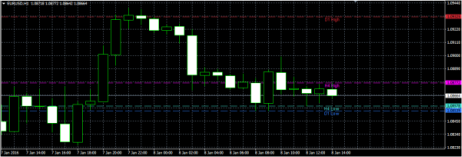FX Blue High-Low indicator for MT4 - User guide
The High-Low indicator is a very flexible tool for showing highs and lows on a chart, from any timeframe and based on any number of bars. You can add multiple copies of the indicator to the same chart in order to display different levels, e.g. the D1 and H4 highs and lows on an H1 chart.
1Overview
The High-Low indicator is a very flexible tool for showing highs and lows on a chart, from any timeframe and based on any number of bars. You can add multiple copies of the indicator to the same chart in order to display different levels, e.g. the D1 and H4 highs and lows on an H1 chart:

The indicator can also show open and close prices as well as the high and low, and can be set to use a daily time range rather than looking at an entire day's trading.
You can also configure the indicator to generate alerts when the current price breaches the historic high or low.
1.1Licence
Unless otherwise specified in writing by FX Blue, this software is licensed for personal use only. You are not allowed to distribute it to other people, regardless of whether or not money is changing hands. You only have a licence to use the software if you, personally, downloaded it from our website.
The software is provided entirely at the user's risk, and you should check it thoroughly before deploying it on computers trading real money. FX Blue accepts no responsibility whatsoever for any loss of any kind caused by installation or use of the software.
2.1Adding the indicator to a chart
You add the High-Low indicator to a chart in the usual MT4 way, either by dragging it from the Navigator onto a chart, or by double-clicking on it in the Navigator. You can also use standard MT4 features such as adding the indicator to your list of Favorites, or assigning a Hotkey to it.
The indicator can be configured in a number of ways using the settings on its Inputs tab, as described below.
2.2Timeframe and number of bars
You can choose the timeframe for the high and low, the bar to start at, and the number of bars to include. For example, choosing D1, previous bar, and 3 bars means that the indicator will draw the high and low of the last 3 days, not including today.
2.3Daily time range
You can set a daily time range so that the indicator only looks at part of each day's trading. This can be particularly useful in relation to equity markets where there is 24-hour trading, but only a core period of e.g. 8 hours during which the market is truly active.
You set the time range in the form hh:mm-hh:mm, e.g. 08:00-15:59
You can also choose whether the time range is only applied to the high and low, or whether it also affects the open and close prices which the indicator calculates.
2.4High and low lines, and widening
You can set the style and colours for the high and low lines. If you are using multiple copies of the indicator on the same chart in order to display different levels, it is obviously best if you set different colours for each indicator. You can turn off the high or low by settings its colour to "none".
You can also choose to widen the high and low lines, e.g. adding (or subtracting) 5 pips from the price. This widening also affects any alerts which you set up. The widening can be defined in terms of pips (e.g. 20), or a price amount (e.g. 0.0020), or a percentage of the range between the high and low.
A negative value for the widening narrows the lines. For example, if the low is at 1.2345, then a value of 10 pips will move the line to 1.2335 (widened away from the high) and a value of -10 will move the line to 1.2355 (narrowed towards the high).
2.5Open and close lines
You can choose to display lines for the open, close, and previous close. Please note: the close line is only useful if you configure the indicator to start at the previous bar rather than the current bar, or if you apply a daily time range. Otherwise, the close line will simply be the current price.
You can turn each of these three lines on and off individually by choosing a colour for it or setting the colour to "none".
2.6Labels
You can choose whether the indicator displays a label for each line, e.g. "D1 High", and you can control the text of the label. You can add the variable {PRICE} into the text to make the indicator display the price value associated with the line.
2.7Alerts
You can choose to get whenever the price goes beyond the high or low lines (including any widening which you have defined). Alerts can be issued as pop-up messages and/or as sounds.
You can set a minimum period between alerts to avoid repeated notifications, and you can also configure the indicator to ignore the first N seconds of the current bar.

